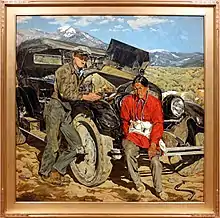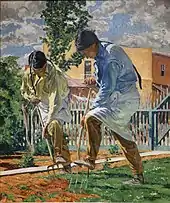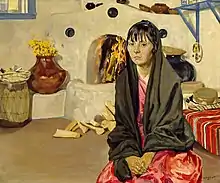Walter Ufer
Walter Ufer (July 22, 1876 – August 2, 1936) was an American artist based in Taos, New Mexico. His most notable work focuses on scenes of Native American life, particularly of the Pueblo Indians.
Walter Ufer N.A | |
|---|---|
.jpg.webp) | |
| Born | July 22, 1876 Huckeswagen, Germany |
| Died | August 2, 1936 (aged 60) Santa Fe, New Mexico |
| Nationality | American |
| Education | Johan Jergens |
| Alma mater | Art Institute of Chicago |
| Known for | Painting, lithography |
| Movement | Taos Society of Artists |
| Spouse(s) | Mary Monrad Frederiksen |
| Awards | 3rd prize, Carnegie International 1920 |
Life and career
Ufer was born in Germany and moved with his family to Louisville, Kentucky in 1880 where Ufer grew up.[1] After an apprenticeship as a lithographer, he went to Europe where he was a traveling journeyman. Like many of his fellow artists with ties to Indianapolis's German-American community, he went to Germany to study; he trained in Hamburg and Dresden.[2] When he returned to America, he worked as a printer in Chicago and taught school, and later took classes in fine arts. After a brief time in Chicago, he returned to Munich in 1911 for further study as an artist. Upon his return to the US, he traveled to Taos in 1914. There he became one of the "Taos Ten", and associated with the Taos Society of Artists. In 1917 Ufer served as president of Chicago's Palette and Chisel, Academy of Fine Arts.
In addition to his art, Ufer is known for his social activism. He helped victims of the 1918 flu epidemic being treated in the local schoolhouse and collected money for miners on strike in Madrid, New Mexico.[3] He was also a member of the Industrial Workers of the World and follower of Leon Trotsky.[1]
Ufer died from appendicitis. At his request, he was cremated and his ashes were spread in an arroyo (creek) near Mabel Dodge Luhan's house in Taos.[4]
Artwork
In the 1920s, Ufer's work garnered critical and commercial success. He showed at the Carnegie International, and became an Academician of the National Academy of Design. Ufer's New Mexico paintings are characterized by genre scenes of Native American life and landscapes executed in a high-keyed palette. One of his favorite models was a Taos Indian named Jim Mirabal who was often referred to as "Ufer's Jim."
Museums with his work include the Art Institute of Chicago, the Museum of Fine Arts, Houston, New Mexico Museum of Art,[5] Taos Art Museum (at Fechin House) and the Indianapolis Museum of Art.
Gallery
 Bob Abbott and His Assistant, 1935, oil on canvas |
.jpg.webp) Jim, 1918, oil on canvas |
 The Garden Makers, 1923, oil on canvas |
 Anna, 1920s, oil on canvas |
See also
References
- Dearinger, David B. (2004). Paintings and Sculpture in the Collection of the National Academy of Design Volume I, 1826-1925. New York: Hudson Hills Press. p. 546. ISBN 1555950299.
- Eldredge, Charles, et al. (1986). Art in New Mexico 1900-1945: Paths to Taos and Santa Fe. Washington, DC: National Museum of American Art with Abbeville Press. p. 208.
- Nelson, Mary Carroll (1980). The Legendary Artists of Taos. New York: Watson-Guptill. p. 76. ISBN 0823027457.
- Nelson, Mary Carroll (1980). The Legendary Artists of Taos. New York: Watson-Guptill. p. 80. ISBN 0823027457.
- Ufer, Walter. "Across An Arroyo". New Mexico Museum of Art. Retrieved 13 January 2014.
External links
- Art Institute of Chicago
- Exhibition of recent paintings, an exhibition catalog containing a foreword by the artist, available from the Metropolitan Museum of Art Libraries.
| Wikimedia Commons has media related to Walter Ufer. |
